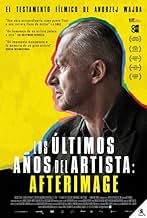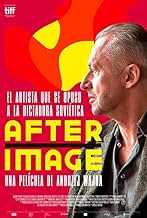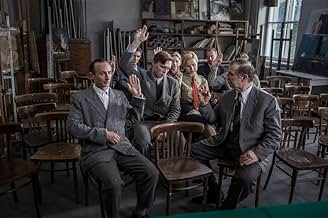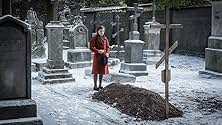The story of charismatic painter Wladyslaw Strzeminski, who opposed social realism and maintained his own artistic freedom in spite of political obstacles.The story of charismatic painter Wladyslaw Strzeminski, who opposed social realism and maintained his own artistic freedom in spite of political obstacles.The story of charismatic painter Wladyslaw Strzeminski, who opposed social realism and maintained his own artistic freedom in spite of political obstacles.
- Director
- Writers
- Stars
- Awards
- 2 wins & 12 nominations total
- Director
- Writers
- All cast & crew
- Production, box office & more at IMDbPro
Featured reviews
The last movie of Andrzej Wajda tells the story of one of the best artists of the 20th Century, Wladyslaw Strzeminski.
The movie states that the situation of a true artist is miserable in spite of the geography, language and culture. Wladyslaw Strzeminski is a great painter, and is suffering due to his personal views, during a great social reformation in Poland. He loose his job, artist license canceled, and ignored in every corner of life. Though his students try to support him, it doesn't make much use. Hungry and sick, a great artist faces the tough realities of life.
The performance of the cast are amazing. Boguslaw Linda as Strzeminski and all the remaining cast have done a wonderful job. Photography and direction is so superb.
I noticed the audience after the movie, they had tears in their eyes. It is so heart touching. Do not miss this movie, if you are a real movie freak!
The film scenes are precise and the transitions between them are remarkably fluid, scary good! The acting is exemplary. The actors are cast perfectly, especially the main actor and the young woman who portrays his long-suffering daughter. Such wonders are the marks of a masterful director. Wajda died just after the completion of the film. Wajda was the trusting sort, said a friend of his, just before the film began. Such trust in his crew paid dividends. Seen at the Miami International Film Festival.
There is one major difference though. Many of his previous films focused on political characters, they were about men who changed history, about victors at least at the historical scale - Danton, Walesa - even if they sometime paid with their lives. The hero of this film, the avant-garde Polish artist Wladyslaw Strzeminski was defeated by history, and the film is the story of his defeat, of his physical but also moral decay. It's a story quite typical about the manner Communist dictatorships in Eastern Europe treated their artists, and even if I did not know anything about him before this movie, his story was well known to me as the same fate (or worse in some cases) was imposed on artists who did not compromise in Romania where I was born and I lived half of my life. We see him at the beginning admired and valued as a teacher and artist, he also was a companion of modernist artists who were associated with the Russian revolution, but this did not help him either. He was not an anti-Communist, but he valued true art, could not accept enrollment of art as a tool for propaganda and the norms of the dogmatic 'realism', and his refusal to compromise cost him his teaching position, his membership in the artist's union, the very possibility of painting. The humiliating tentative to find a way to survive had no chance, the regime was still in the Stalinist period and crushed all opponents according to the principle 'the one who is not with us is against us'. Even the help and support of a handful of students who stood by their beloved teacher and mentor could not save him.
The lead role is played with a lot of restraint and dignity by Boguslaw Linda, his flame is interior, he shows the artist far from being a flawless person, actually sharing some of the guilt of not being able to maintain his family and especially help his teen daughter (exceptional acting of 14 years old Bronislawa Zamachowska). There are many very well constructed scenes, some of them full with details bringing back to life with controlled anger that dark period of transformation, when Poland and Eastern Europe were postponing hope for a few decades and were transitioning from one nightmare to another. Wajda's last film is not a testament, it's an integral part of his opus of work.
It was crazy how they used the system to basically suppress him as the qualifications to work in his country were ridiculously and being crippled met that he did not meet enough standards to receive a stamp on his work Visa that said he could work as an artist. The art store would not even sell him paint if he did not have his work ID. So this guy wanted to work and was more than capable of being an artist despite his limitations, but they would not simply because his thoughts went against what was popular at the moment.
I find it interesting that movies about the events around World War II seem to be popping up a lot. My first thought was that people are getting tired of movies about Iraq or Afghanistan like possibly people got tired of the constant references of Vietnam in every 1980s TV show, but I'm starting to think that's not the case. Even though life in the present is no where near as hard as what they went through back then, I'm noticing some trends from yesteryear coming back into fashion and these movies are used to keep in are minds fresh the idea that those who do not know history are doom to repeat it.
I don't know if this story is based on truth, but it's definitely inspired by things that did happen, which makes it a very educational film, but at the same time it was very entertaining, with great acting and very good visuals. The relationship between the painter and his students was very colorful. Afterimage does a great job at hinting at things without hitting you over the head with it, which I liked.
Not what I was expecting when going to the theater, but well worth watching.
http://cinemagardens.com
Did you know
- TriviaOfficial submission of Poland for the 'Best Foreign Language Film' category of the 89th Academy Awards in 2017.
- Quotes
Wladyslaw Strzeminski: They praise the ones who suck up. They're silent about the real artists.
Julian Przybos: I spoke about this with Milosz. He also believes that an artist who can't speak with a full voice should be silent. Artists can be killed in two ways: either by talking about them too much or not at all.
- ConnectionsReferences L'homme de marbre (1977)
- SoundtracksLandscape
Written by Andrzej Panufnik
Performed by Narodowa Orkiestra Symfoniczna Polskiego Radia w Katowicach
Conducted by Piotr Komorowski
- How long is Afterimage?Powered by Alexa
Details
Box office
- Gross US & Canada
- $33,443
- Opening weekend US & Canada
- $5,832
- May 21, 2017
- Gross worldwide
- $1,032,768
- Runtime1 hour 38 minutes
- Color
- Sound mix
- Aspect ratio
- 2.35 : 1
Contribute to this page



































